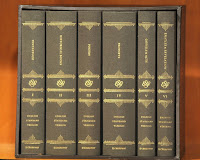“For everything that was written in the past was written to teach us, so that through the endurance taught in the Scriptures and the encouragement they provide we might have hope.” (Rom 15:3).It may seem like a bait-and-switch to start talking about the Bible now. As much as I want to talk about God, it’s necessary to start here. The Bible is the source for most of what we know about God, so it’s important to know whether we can trust it, how we got it, and how to use it.
And before we can talk about all of that, we need to talk about exactly what it is.
The Bible is not a book. It is a library. There are 66 books in the Protestant*
 |
| The Bible printed like a normal book. |
The first 39 books we inherited from the Jews. We usually call them “the Old Testament” — meaning that they contain the old covenant (or testament), though in reality they contain more than one covenant. Jews call them “the Bible.” Many today refer to them as “the Hebrew scriptures.” Jesus usually called them “the Law and the Prophets.” The apostles simply called them “the Scriptures.” These works were written by prophets, kings, and government officials. They contain the history of how God dealt with Israel and his promises to them as well as their worship and wisdom literature.
The 27 books of the New Testament are the writings of the apostles and their students. The four gospels contain their memories of the life and teachings of Christ, and the epistles are their application of his death, resurrection, and teachings to life as a Christian.
With that history in mind, it is important to know how to read the Bible well. There are three keys to this: context, context, and context.
Literary context is the grammatical context of the passage and the type of literature — for example, whether you’re reading history (which you would read in a more straight-forward fashion) or poetry (where you expect figures of speech and symbols). This ought to be the simplest thing to deal with, but in practice Christians don’t always do this well.
There were no chapters and verses in the original writings (except the Psalms). A verse cannot be understood apart from the paragraph it is a part of. A paragraph must be understood in light of the larger passage. Yet people continually try to isolate verses from their context resulting in grossly misunderstanding — and misusing — them.
The same goes for the genre (that is, type of literature) of books. Proverbs are not promises, and figures of speech in poetry should not be taken literalistically. Nor should you try to allegorize passages in historical books. Keeping the type of literature you’re reading in mind is very important when reading the Bible.
Historical context is the world in which the book was written. Every book was written by a specific person to specific people. Their culture, language, and world view were influenced by when and where they lived, and we have to try to read the text through their eyes. A text cannot mean to us what it could not have meant to the original audience.
Theological context is what the author knew about God. God revealed more of himself and his plan over time. Conditions changed. We have to read the text in light of what the authors knew and apply it in light of what we know. One common mistake is to read the Law of Moses (Genesis through Deuteronomy) and try to apply it to our day. The Law was fulfilled by Christ’s death and resurrection. It is not binding on Christians.
There are plenty of tools to help us with those three things. Bible handbooks, commentaries, study Bibles, and Bible dictionaries help us keep these contexts in mind as we read.
After we read the Bible well, we are not done. The Bible was not given to us to entertain us or to merely enlighten us. It was given to change us. “All Scripture is God-breathed and is useful for teaching, rebuking, correcting and training in righteousness, so that the servant of God may be thoroughly equipped for every good work” (2 Tim 3:16-17).
You cannot know God without spending time in the Scriptures. But that time was spent in vain if you do not put into practice what you see there.
Does this seem a little daunting? Don’t let it put you off. God gave us his word so that we may know him and know what he wants from us. He intended it to be understandable. It takes a little work, but every worthwhile thing requires some work. Putting in the effort will pay off immensely.
* The Protestants’ Bible contains fewer books than that used by the Roman Catholics or the Eastern Orthodox.
Part of Christianity 101
No comments:
Post a Comment